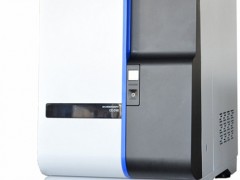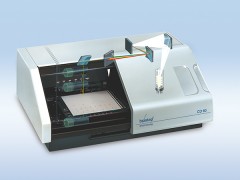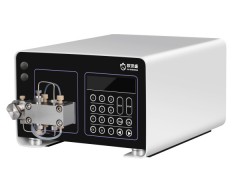Thin films are deposited on substrates in a variety of vacuum deposition processes. The properties of such a deposited film depends on the cleanliness of the substrate surface on which the film is deposited. Contamination on this surface can result in reduced adhesion of the film to the substrate, more rapid degradation of the film after deposition, greater contact resistance for electrically conducting films, and poor optical qualities for optical films.
Even with careful handling, surface contamination in the form of adsorbed water vapor and a variety of hydrocarbons results from exposure to the laboratory atmosphere prior to deposition. This exposure can also cause the formation of native oxide layers on reactive substrate materials. To remove this surface contamination, it is necessary to clean the substrate surface after it is in a vacuum environment and can no longer be contaminated by the laboratory atmosphere, but before the thin film is deposited. Glow discharges and ion beams have both been used for this in-situ cleaning.
GLOW-DISCHARGE CLEANING
A wide range of dc and rf glow discharges are used for in-situ cleaning. Equipment for dc operation is generally less costly and probably more widely used. For dc, operating voltages range from several hundred volts to several kilovolts. The most common gases for the discharge are air, oxygen, nitrogen, an inert gas, or a mixture of two or more of these. The gas pressures range from a fraction of a Torr up to several Torr.
The gas pressure for a glow discharge is usually well above the permissible background pressure for deposition, and constitutes a major limitation of glow-discharge cleaning. For a typical background pressure of 1 Torr, the mean-free-path length of a background molecule is of the order of 0.05 mm. While the path length of a more energetic ion is longer, it is still only of the order of 0.5 mm.[1] Both of these distances are quite small compared to chamber dimensions, so that diffusion of contaminants back to the surface from which they were removed is a problem. A glow discharge is also not very selective of the surfaces bombarded, so that there is an exchange of contaminants between nearby surfaces.
The redeposition that results from the high pressure and the non-selective nature of a glow discharge is probably the reason for the frequent use of oxygen, nitrogen, or a mixture that includes one or both of these. Oxygen and nitrogen are highly reactive in atomic or ionic form so that, even though the contamination is only partly removed from the substrate surface, the discharge products will react with what is left. As one example, hydrocarbon contaminants can be at least partially removed as gaseous CO and H2O by the use of oxygen in the background. As a less desirable example, an oxygen discharge can also result in the more rapid growth of an oxide layer than would occur in an atmospheric exposure.
In addition to modifying contaminants to more, or less, volatile forms, some of the glow-discharge cleaning probably consists of encapsulating contaminants with low-volatility deposits from elsewhere in the vacuum chamber.
When glow-discharge cleaning is completed, the high background pressure requires further pumping before the deposition of a thin film can be started. The high background pressure and the time for pumping both contribute to the accumulation of new contamination on the substrate surface before the start of deposition.
Although a glow discharge can be limited in its cleaning effectiveness, it can still give improved properties of deposited films, particularly in adhesion, when compared to the properties of films deposited without any in-situ cleaning.
ION-BEAM CLEANING
Both gridded and gridless ion sources[2] have been used to generate ion beams for in-situ cleaning. Gridded ion sources permit better control of ion-beam coverage, but gridless (end-Hall) sources are more cost-effective in generating the low-energy ion beams that are most frequently used for cleaning. In both cases, argon is the most common operating gas.
Ion beams have several advantages over glow discharges for in-situ cleaning. An ion beam is much more selective in that the energetic ions can be directed at a substrate, resulting in the removal of contaminants only from the substrate and
Technical Note KRI-06
immediately adjacent surfaces. The ability to vary the ion
energy independently of other parameters is also important. For removal of physisorbed contaminants such as water vapor and hydrocarbons from the laboratory environment, low ion energy are effective and energies of less than 100 eV avoid damage to, or significant sputtering of, the substrate surface. An effective cleaning dose for removal of physisorbed contaminants is quite small - less than one mA-sec/cm2.[3]
On the other hand, higher ion energies can be used for the removal of chemisorbed layers, such as native oxides. The stronger chemisorbed bonds generally require ion energies of at least 100 eV, with the required dose calculated from the sputter yield of the contaminant and its thickness.
The lower background pressure is a major advantage for ion-beam cleaning. The background pressure depends on the vacuum pumping used, but is usually in the 10-4 Torr range, resulting in mean free paths that are thousands of times longer than in glow-discharge cleaning. These longer paths greatly increase the likelihood that contaminants, once they are removed from the substrate surface, will be pumped from the vacuum chamber before they can return to that surface. The low background pressure also permits the deposition of a thin film to start rapidly after cleaning, thereby minimizing the new contamination that can accumulate between the cleaning and deposition steps. The rule-of-thumb is that a monolayer of contamination can accumulate in one second from a contaminant background pressure of 10-6 Torr. But it is important to remember that the background pressure of the contaminant is what counts, not the total background pressure which is typically almost all argon.
ConCLUDING REMARKS
In general, if the partial removal of contaminants, together with the reduction in volatility of residual contaminants, gives satisfactory properties for the films being deposited, then glow-discharge cleaning can be an acceptable, cost-effective process. But if the desired film properties require the essentially complete removal of the contaminants, rather than just modifying them to a more passive form, then ion-beam cleaning is recommended.
The preceding discussion only addresses the effects of cleaning. Depending on the deposition process and the material being deposited, ion assist during deposition can result in additional improvements in the thin-film properties.[3,4]
REFERENCES
Staff of K R, Charge and Momentum Exchange in an Ion Beam, Technical Note KRI-03, 2003. Staff of K R, Broad-Beam Industrial Ion Sources, Technical Note KRI-01, 2003. H. R. Kaufman and J. M. E. Harper, Ion-Assist Applications of Broad-Beam Ion Sources, Proceedings of SPIE, Vol. 5527, pp. 50-68. Aug. 2004. Staff of K R, Ion-Assist Doses, Technical Note KRI-05, 2005, 2006.
電話:+86-21-5046-3511
郵箱:ec@hakuto-vacuum.cn
地址:上海市浦東新區(qū)
新金橋路1888號36號樓7樓702室
201206
詳細資訊
 手機版|
手機版|

 二維碼|
二維碼|











